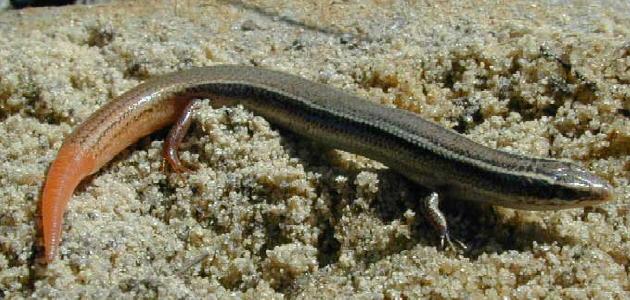Mole Skink (Eumeces egregius) - Wiki Mole Skink
From Wikipedia, the free encyclopedia
[Photo] Peninsula Mole Skink, Eumeces egregius onocrepis. From the U.S. Geological Survey.
Mole Skinks (Eumeces egregius) are small lizards living in Florida.
Taxonomy
The species is further subdivided in five subspecies:
- Florida Keys Mole Skink, E.e. egregius Baird 1859: occurs only on some of the Florida Keys.
- Cedar Key Mole Skink, E.e. insularis Mount 1965: occurs only on three islands at Cedar Key.
- Bluetail Mole Skink, E.e. lividus Mount 1965: occurs only in interior central Florida; shares habitat with the Sand Skink.
- Peninsula Mole Skink, E.e. onocrepis Cope 1871.
- Northern Mole Skink, E.e. similis McConkey 1957.
The species was first described by Baird in 1859 as Plistodon egregius. In 1871, P. onocrepis was described by Cope. In 1875, the two species were reassigned to the genus Eumeces. In 1935, two subspecies were defined, E.e. egregius and E.e. onocrepis, and in 1957, E.e. similis was separated from E.e. egregius.
Status
The first three subspecies listed above are protected, and the Bluetail Mole Skink is classified as an endangered species since 1987. The major threats to all three subspecies are habitat destruction due to residential, commercial, and agricultural development and overcollection by herpetological enthusiasts. The remaining two subspecies are rather common. The Northern Mole Skink also occurs in southern Alabama and Georgia.
Habitat
Mole skinks are found in sandhills and scrub.
Reproduction
Mole Skinks reach sexual maturity after one year. They mate in winter; the female lays three to seven eggs in spring in a shallow nest cavity less than 30 cm below the surface. The eggs incubate for 31 to 51 days, during which time the female tends the nest.
The Bluetail Mole Skink
The Bluetail Mole Skink is a small, shiny, cylindrical lizard of a brownish color. Juveniles usually have a blue tail which makes up slightly more than half of the animal's length. Regenerated tails and the tails of older individuals are typically pinkish. The legs are somewhat reduced in size and are used only during surface locomotion, not when the animal "swims" through the sand (Christman 1992). During the breeding season, males develop a colorful orange pattern on their sides.
The Bluetail Mole Skink grows to 9 to 15 cm (3 to 6 inches). It shares habitat with the Sand Skink, which is also endangered, but does not compete with it: whereas the Sand Skink feeds underground, the Bluetail Mole Skink hunts on the surface. Like other mole skinks, it feeds primarily on cockroaches, spiders, and crickets.
The Bluetail Mole Skink is an endangered species.
http://en.wikipedia.org/wiki/Mole_Skink
| The text in this page is based on the copyrighted Wikipedia article shown in above URL. It is used under the GNU Free Documentation License. You may redistribute it, verbatim or modified, providing that you comply with the terms of the GFDL. |
